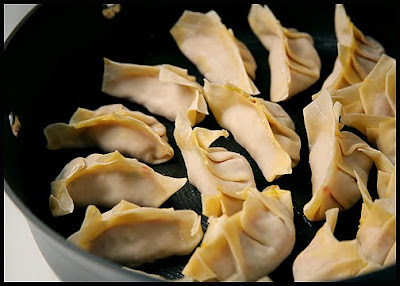Gyoza have a more intense garlic flavor than jiaozi. Traditionally, the filling consists of a ground meat, vegatable, or shrimp. The filling is tucked into the dumpling by crimping the edges and served with a dipping sauce.
The Japanese use the preparation method of yaki-gyōza (焼き餃子), it first fried on the flat side, creating a crispy skin. Then, water is added and the pan sealed with a lid, until the the gyoza is steamed.
I brought in a guest chef, my girlfriend, Ryoko, to prepare the Gyoza. She is a Master at the art of Japanese-style dumplings.
We start with the filling of ground pork, green onions, garlic, cabbage, and ginger.
The preparation is a difficult task which require dexturous hands. Ryoko is so fast it is hard to keep up. Prepare the wonton with busted egg yolk to seal the edges. Place the filling in the middle.
Crimp the edges together to seal the filling into the dumpling. This particular step is hard for me due to my “sausage-size” fingers.
This is what a professional Gyoza dumpling should look like before cooking. Great job Ryoko, it’s beautiful.
In America, “potstickers” are usually served as an appetizer but they are just as suitable and fulfilling as a main course.
Make as many as you desire but beware, what you think is enough, isn’t!!! Ryoko’s Gyoza are so good, they don’t remain on the plate very long.
While Ryoko was preparing the Gyoza, I made the dipping sauce, which my non-dexturous hands could handle. Made of thinly-sliced red-green chiles, green onions, vinegar, soy sauce, and a touch of sugar, it provides a great accompaniment to the Gyoza.
Ryoko’s gyoza consists of the crispy bottom. Sear over a hot pan until a brown crust has developed. Then it is time to cover the pan, add some water, and steam until they have become slightly transparent, a few minutes.
The gyoza was/is absolutely amazingly tasty. It takes some practice to crimp the edges well and present it in a beautiful way. I am truly lucky to have Ryoko in my life to make such a delightful traditional Japanese dish.
Dōmo arigatō Ryoko!
Served with Rice, Chile Pepper Soy Sauce dip, Sriracha sauce.
Enjoi !















No comments:
Post a Comment